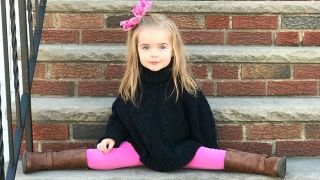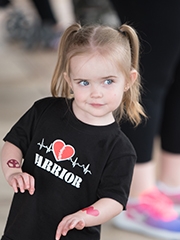Left Ventricular Noncompaction Cardiomyopathy: Lena’s Story
Published on
Published on
Lena is a strong-willed 2-year-old, and her parents love her feistiness. When she was a baby, she had a nearly fatal experience. She was saved by an ambulance team and by the Cardiac Center team at Children’s Hospital of Philadelphia (CHOP).
 When Lena was 3 months old, she went into sudden cardiac arrest. Her mother, Maureen, was driving near their home in New Jersey with Lena and her older sister in the back seat when it happened. “Lena made a very weird noise, like moaning,” Maureen remembers. “I pulled over and saw that she was turning blue. She wasn’t breathing. I grabbed her from her car seat and she went limp in my arms.”
When Lena was 3 months old, she went into sudden cardiac arrest. Her mother, Maureen, was driving near their home in New Jersey with Lena and her older sister in the back seat when it happened. “Lena made a very weird noise, like moaning,” Maureen remembers. “I pulled over and saw that she was turning blue. She wasn’t breathing. I grabbed her from her car seat and she went limp in my arms.”
Maureen first tried to blow air into Lena’s mouth, then immediately called 911. While they waited for the ambulance to arrive, the dispatcher explained to Maureen over the phone how to do CPR on her baby, laying her down on the sidewalk and using her thumbs to press on her chest.
“I focused on her lips while I did CPR,” Maureen says. “They had gone greyish white, no color at all. Then I saw them get pink.” When the ambulance arrived, Maureen handed Lena to the EMT. “Our older daughter was losing it this whole time, and once the EMT had Lena, I lost it, too. I asked how she looked, and the EMT told me, ‘Right now, she doesn’t have a pulse.’”
During her resuscitation by the EMTs, Lena had evidence of an irregular heart rhythm called ventricular fibrillation for which she received two AED shocks to revert her to normal rhythm.
The chief of police drove the ambulance so both EMTs could care for Lena, and a police sergeant followed them in Maureen’s car. The police in three towns worked together to block off intersections and a bridge on the route to the hospital.
When they arrived, Maureen saw the EMT who had been caring for Lena leaning against the side of the ambulance, crying, being comforted by a nurse. “I jumped out and ran into the ER,” Maureen says. “When I got inside, the other EMT, the one who told me she had no pulse, told me, ‘She’s OK. Come this way.’ That’s when I heard her crying.”
Lena was alive, but would have a long journey ahead. Doctors needed to find out what had caused her heart to stop. Within the hour, she was transferred by ambulance to another New Jersey hospital, where a cardiologist did a scan of her heart and noticed that something was wrong with her left ventricle. He called colleagues at Children’s Hospital of Philadelphia (CHOP) to discuss what he was seeing, and together they agreed that Lena should be transferred there. A team was sent in an ambulance to pick her up.
Maureen, along with Lena’s father, Junior, and her older siblings, Lily and Aiden, drove to CHOP, where they met with cardiologist Anita Szwast, MD, and electrophysiologist V. R. Iyer, MD.
After a series of additional tests and imaging studies, Dr. Szwast and Dr. Iyer told Maureen and Junior that Lena had two heart conditions. One was left ventricular noncompaction cardiomyopathy (LVNC), an abnormal development of the heart that leaves it thick and spongy with pieces of muscle that extend into the chamber. In Lena’s case, the left ventricle was unable to fully compress with each heartbeat.
The other condition was Wolff-Parkinson-White syndrome, which meant Lena had extra electrical pathways between her heart’s upper and lower chamber, causing periodic episodes of rapid heartbeat (arrhythmia). The doctors explained that the combination of the two conditions had caused Lena’s heart to stop in the car.
Lena stayed at CHOP for close observation and additional testing including an electrophysiology study, performed with cardiac catheterization. She underwent a successful radiofrequency ablation which eliminated multiple electrical pathways that were causing her arrhythmias. She is one of the youngest patient (at 3 months) to undergo this procedure at CHOP.
After reviewing the information from all of the imaging studies and tests, and discussing what they had observed during Lena’s procedure, the medical team decided that she would need an implantable cardioverter defibrillator (ICD). This was because Lena was still susceptible to having life-threatening arrhythmias because of the second condition: left ventricular non-compaction.
When a rapid heart rhythms persists and exceeds the ICDs preprogrammed heart rate threshold, the ICD is able to deliver an electrical rescue shock to restore the normal heart rate. All ICDs are also pacemakers and are capable of pacing the heart when abnormally slow rhythms occur.
Christopher Mascio, MD, an attending surgeon with the Cardiac Center, performed the surgery to implant the ICD, again one of the smallest children at CHOP to undergo this procedure. After 24 days at CHOP, less than a month after her incident in the car, Lena was released to go home. She had a tiny defibrillator in her belly and was on a regular dose of medication to help control her arrhythmia.
“She has been shocked a few times,” says Maureen. Every time the defibrillator is activated, her team at CHOP is automatically notified through a remote sensor. It was through that monitoring process that the family learned that Lena’s ICD has been able to restore her normal heart rate and rhythm. Noncritical data from the ICD is stored on a device in the family’s home, and is sent to CHOP monthly for review.
Lena goes back to CHOP regularly for follow-up with her medical team, which includes cardiologists R. Lee Vogel, MD, and Matthew O'Connor, MD. She also participates in the Cardiac Kids Developmental Follow-up Program, which brings together specialists to help monitor patients with complex congenital heart disease for developmental and neurological issues, and to provide guidance to parents on how to help their children lead as normal a life as possible.
 Today, Lena is a typical 2-year-old. “She’s very independent, very strong-willed,” says Maureen. “She does what she wants.” She loves bulldogs, and tries to do whatever her older sister is doing.
Today, Lena is a typical 2-year-old. “She’s very independent, very strong-willed,” says Maureen. “She does what she wants.” She loves bulldogs, and tries to do whatever her older sister is doing.
The family hasn’t forgotten or lost touch with the ambulance team. The EMT who was crying outside the hospital on that dramatic day has since explained to Maureen what was happening at that moment. He was so relieved that Lena was OK that he had to step outside. He had been overcome with emotion. Now, they have dinner together every year at the holidays — and again on Lena’s birthday.
The medical team at CHOP has become like an extension of the family. “Every single person we have dealt with has cared about Lena like she was their own kid,” says Maureen.
“I remember sitting with a nurse and an intern before her surgery, and all three of us were crying. When we go back, we always get hugs. If I call with a concern, they will talk to me and answer all my questions..”